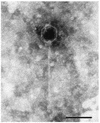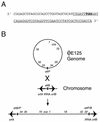Burkholderia thailandensis E125 harbors a temperate bacteriophage specific for Burkholderia mallei
- PMID: 12081973
- PMCID: PMC135171
- DOI: 10.1128/JB.184.14.4003-4017.2002
Burkholderia thailandensis E125 harbors a temperate bacteriophage specific for Burkholderia mallei
Abstract
Burkholderia thailandensis is a nonpathogenic gram-negative bacillus that is closely related to Burkholderia mallei and Burkholderia pseudomallei. We found that B. thailandensis E125 spontaneously produced a bacteriophage, termed phiE125, which formed turbid plaques in top agar containing B. mallei ATCC 23344. We examined the host range of phiE125 and found that it formed plaques on B. mallei but not on any other bacterial species tested, including B. thailandensis and B. pseudomallei. Examination of the bacteriophage by transmission electron microscopy revealed an isometric head and a long noncontractile tail. B. mallei NCTC 120 and B. mallei DB110795 were resistant to infection with phiE125 and did not produce lipopolysaccharide (LPS) O antigen due to IS407A insertions in wbiE and wbiG, respectively. wbiE was provided in trans on a broad-host-range plasmid to B. mallei NCTC 120, and it restored LPS O-antigen production and susceptibility to phiE125. The 53,373-bp phiE125 genome contained 70 genes, an IS3 family insertion sequence (ISBt3), and an attachment site (attP) encompassing the 3' end of a proline tRNA (UGG) gene. While the overall genetic organization of the phiE125 genome was similar to lambda-like bacteriophages and prophages, it also possessed a novel cluster of putative replication and lysogeny genes. The phiE125 genome encoded an adenine and a cytosine methyltransferase, and purified bacteriophage DNA contained both N6-methyladenine and N4-methylcytosine. The results presented here demonstrate that phiE125 is a new member of the lambda supergroup of Siphoviridae that may be useful as a diagnostic tool for B. mallei.
Figures





Similar articles
-
Genomic diversity of Burkholderia pseudomallei clinical isolates: subtractive hybridization reveals a Burkholderia mallei-specific prophage in B. pseudomallei 1026b.J Bacteriol. 2004 Jun;186(12):3938-50. doi: 10.1128/JB.186.12.3938-3950.2004. J Bacteriol. 2004. PMID: 15175308 Free PMC article.
-
DNA methylation in lysogens of pathogenic Burkholderia spp. requires prophage induction and is restricted to excised phage DNA.J Bacteriol. 2005 Feb;187(3):1196-200. doi: 10.1128/JB.187.3.1196-1200.2005. J Bacteriol. 2005. PMID: 15659696 Free PMC article.
-
φX216, a P2-like bacteriophage with broad Burkholderia pseudomallei and B. mallei strain infectivity.BMC Microbiol. 2012 Dec 7;12:289. doi: 10.1186/1471-2180-12-289. BMC Microbiol. 2012. PMID: 23217012 Free PMC article.
-
PCR-based Methodologies Used to Detect and Differentiate the Burkholderia pseudomallei complex: B. pseudomallei, B. mallei, and B. thailandensis.Curr Issues Mol Biol. 2014;16:23-54. Epub 2013 Aug 22. Curr Issues Mol Biol. 2014. PMID: 23969318 Review.
-
Development of Burkholderia mallei and pseudomallei vaccines.Front Cell Infect Microbiol. 2013 Mar 11;3:10. doi: 10.3389/fcimb.2013.00010. eCollection 2013. Front Cell Infect Microbiol. 2013. PMID: 23508691 Free PMC article. Review.
Cited by
-
Patterns of large-scale genomic variation in virulent and avirulent Burkholderia species.Genome Res. 2004 Nov;14(11):2295-307. doi: 10.1101/gr.1608904. Genome Res. 2004. PMID: 15520292 Free PMC article.
-
Isolation of new Stenotrophomonas bacteriophages and genomic characterization of temperate phage S1.Appl Environ Microbiol. 2008 Dec;74(24):7552-60. doi: 10.1128/AEM.01709-08. Epub 2008 Oct 24. Appl Environ Microbiol. 2008. PMID: 18952876 Free PMC article.
-
Burkholderia mallei expresses a unique lipopolysaccharide mixture that is a potent activator of human Toll-like receptor 4 complexes.Mol Microbiol. 2007 Jan;63(2):379-90. doi: 10.1111/j.1365-2958.2006.05519.x. Epub 2006 Dec 5. Mol Microbiol. 2007. PMID: 17163980 Free PMC article.
-
Chromosomal targeting by CRISPR-Cas systems can contribute to genome plasticity in bacteria.Mob Genet Elements. 2013 Sep 1;3(5):e26831. doi: 10.4161/mge.26831. Epub 2013 Oct 25. Mob Genet Elements. 2013. PMID: 24251073 Free PMC article.
-
Mapping of the Denitrification Pathway in Burkholderia thailandensis by Genome-Wide Mutant Profiling.J Bacteriol. 2020 Nov 4;202(23):e00304-20. doi: 10.1128/JB.00304-20. Print 2020 Nov 4. J Bacteriol. 2020. PMID: 32900830 Free PMC article.
References
-
- Ackermann, H.-W. 2001. Frequency of morphological phage descriptions in the year 2000. Arch. Virol. 146:843-857. - PubMed
-
- Alibek, K., and S. Handelman. 1999. Biohazard: the chilling true story of the largest covert biological weapons program in the world. Random House, New York, N.Y.
-
- Anuntagool, N., P. Aramsri, T. Panichakul, V. Wuthiekanun, R. Kinoshita, N. J. White, and S. Sirisinha. 2000. Antigenic heterogeneity of lipopolysaccharide among Burkholderia pseudomallei clinical isolates. Southeast Asian J. Trop. Med. Public Health 31:146-152. - PubMed
Publication types
MeSH terms
Substances
LinkOut - more resources
Full Text Sources
Other Literature Sources
Molecular Biology Databases

